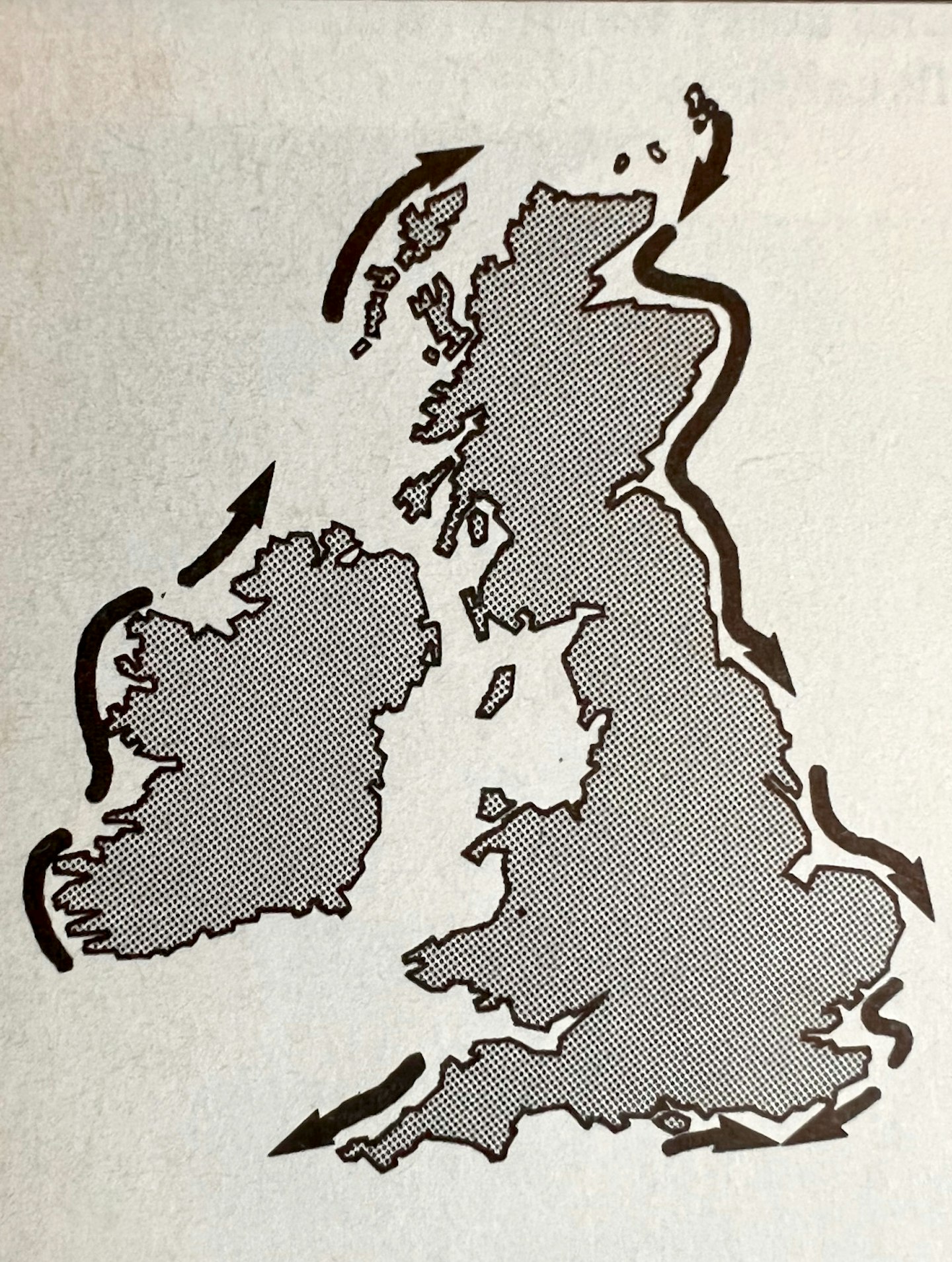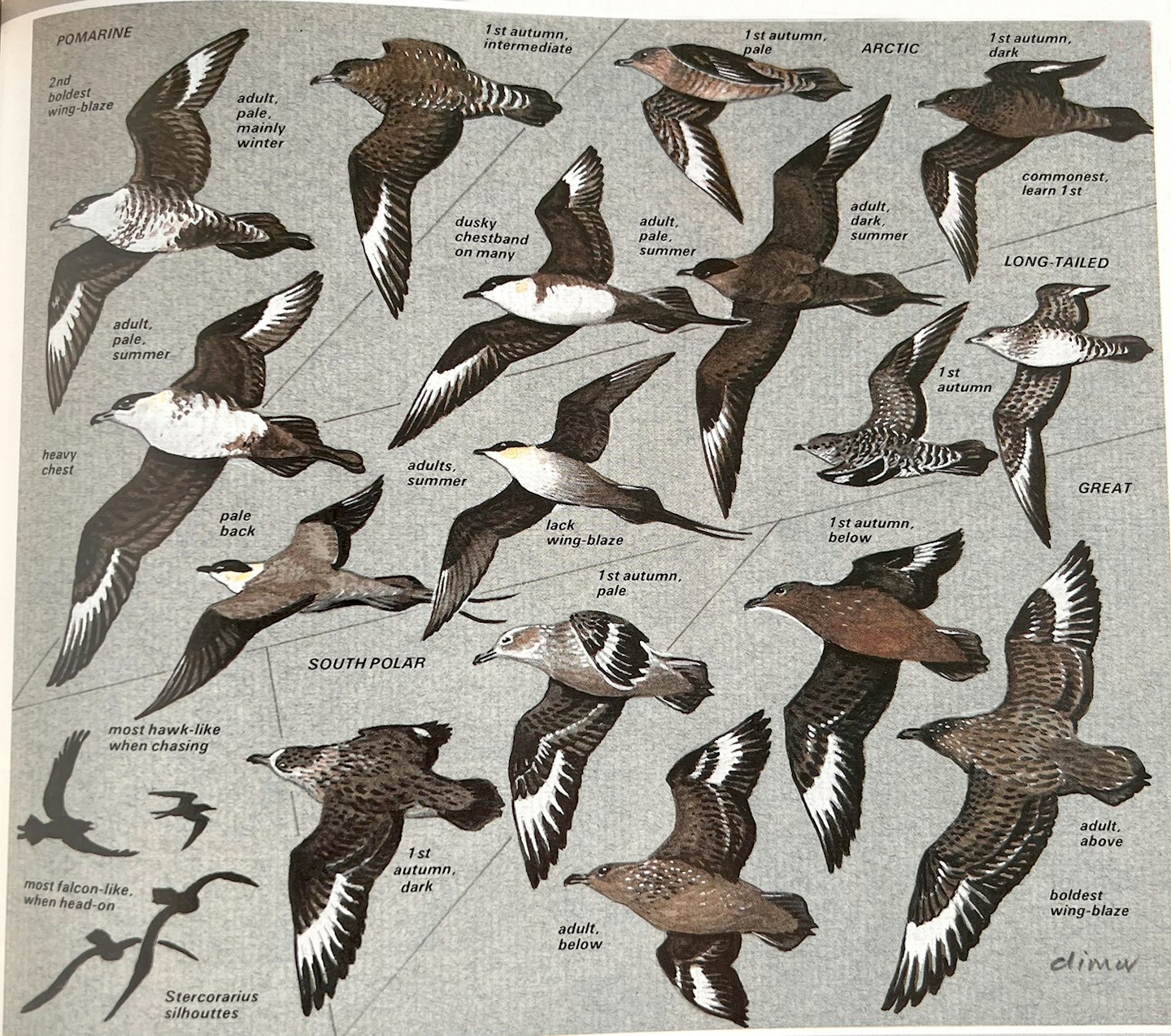Muggers of the Ocean
November 1986
IF a dark, menacing "gull x falcon" appears from nowhere to chase the last meal – or life – out of another seabird, it is a skua and no mistake. Your problems start when you want to put a specific name to it. Here IAN WALLACE gives you some clues – the full solutions will come only with experience.
ALL your Northern skuas – the Great, Pomarine, Arctic and Long-tailed, occur regularly off the flanks of Britain and Ireland. One of the three Antarctic species – the South Polar – reaches the western North Atlantic and was claimed off Cornwall in 1982. Thus this article's subjects number only five, but they are such splendid (and confusing) birds that discussion space is always at a premium. Here it is largely devoted to their separation in flight.
Skua identifications rest as much, if not more, on their general characters as their notoriously variable plumage patterns. To perceive the birds as "beings", you must learn to piece together size, structure, flight action and hunting behaviour. Beware straining hopelessly after feather details at half-a-mile in a dark gale.
In the plate, I have depicted the commonest plumages worn from spring to mid-autumn and these should suffice to get you started. To understand fully the complexities of colour phases, winter plumages and age progressions, you will have to read Peter Harrison's Seabirds (1986) or, better still, the texts of The Birds of the Western Palearctic, Vol.3 (1983).
Skua systematics are still unsettled but there are two distinct groups in the family: (1) the big, primarily Antarctic species with gull-like forms and no tail streamers and (2) the smaller, all Northern species with falcon-like forms and (in adults) conspicuous tail streamers. Always keep this basic divide in mind, even if you don't bother to separate them generically as respectively Catharacta and Stercorarius.
Birds do not often recall mammals, but somehow (to my eyes) skuas do. It may help you to think of the Catharacta pair – the Great and South Polar – as "bears” and the Stercorarius trio – the Pomarine, Arctic and Long-tailed – as (in order) "wolverine", "marten” and "stoat".
Likely order of sighting
Two skuas breed in Scotland, the Arctic – 2,850 pairs – and the Great – 8,500 pairs (numbers are similar in 2022). The former pours, and the latter streams, down the East Coast in autumn: the odds are that you will see them first and so get a good opportunity to "key in" the general character of both the Stercorarius and the Catharacta groups.
You should come next across a Pomarine, with best chances in late spring off north-west Ireland and in late autumn along the East Coast, and last of all the superb Long-tailed with best chance from late summer to mid-autumn along the East Coast.
Finding the "holy grail" of a South Polar will mean a sustained commitment to notching up thousands of skua/days off west Ireland or north Cornwall, but you might be lucky!

Spring passage most noticeable on west facing coasts (with NW winds) but also off Channel headlands. Autumn passage mainly east coast phenomenon (with N to E winds) but also off north Cornwall (after SW and NW gales.

Skua sizes decrease from the Great and South Polar through Pomarine, then Arctic to Long-tailed. In any pair; overlaps in measurements occur but happily each species presents consistent structural differences.
Great recalls largest of gulls/buzzard; head/body/tail merge into "fat cigar" shape; wings broad with triangular points; tail-points small, usually invisible.
South Polar as Great but bill and head slighter. Pomarine recalls large gull/broad-winged hawk or falcon; bill most hooked; head strong; body thick-set, with chest bump; wings broad based but with long points; tail streamers either long, with twisted wooden “spoon" shape (or trailing blob) in adult or short and blunt in immature.
Arctic recalls falcon; build intermediate between smallest Pomarine and largest Long-tailed, with – compared to former – less heavy bill/head and much less chest, narrower wings and ramp and always pointed tail streamers and – compared to latter – greater weight, less narrow wings, relatively shorter rump, tail base and streamers (last pointed in immature).
Long-tailed recall small falcon/gull or even tern; most slender and attenuated; head small; wings long/ narrow and sometimes set like shearwater's and rump and tail base long; streamers of adult long and whipping but only visible at close range; of immature short and blunt.
Beware dependence on tail streamer shape and length in smaller skua identifications. Streamers take time to grow and can break off!
FLIGHT ACTION AND HUNTING TACTICS
Great and South Polar fly with constant, rather laboured strokes and little wing flexing; usually hug the sea; in attack, pad up on targets and then switch to sustained chase, with tail buffet – wing-biting for example – when intent on kill and not mere disgorge.
Pomarine beats wings with rather slow, deep and regular flaps, interrupted by more shears on flexed wings than Catharacta pair; most gull-like but some migrants travel well above sea, like raptors; in attack, changes gear to display more speed/savagery than any other skua.
Arctic flies with somewhat erratic, yet graceful wing-beats, frequently interrupted by sails, shears and descendent glides, giving overall speedy but wandering track to bird's progress; in attack, either sneaks in low or turns suddenly off passage into direct chase.
Long-tailed floats along with light rowing strokes, its tern-like action allowing it freer changes in height than any other skua; into strong winds, stays in wave troughs, slinking between them or occasionally careering above them like shearwater; in rare attacks on small seabirds, agile but less powerful than larger kin; may dip down to or land on sea to pick up surface organisms.
PLUMAGE PATTERNS
Basic rules
1. All skuas except adult Long-tailed (and a few dark Arctics) have white blazes on their outer wings. These are large in Great and South Polar, medium-sized in Pomarine and medium-sized to small in Arctic and immature Long-tailed.
2. All skuas except Great appear in pale, intermediate and dark phases, most evident in under body colour. Except in southern-breeding Arctics, the dark phases are rare – only 1 in 20 Pomarines and less than 1 in 1,000 Long-taileds
3. Stercorarius skuas are barred on saddle, rump and under-surfaces when young and in winter, though not when adult on wing-linings.
4. Adult pale or intermediate Stercorarius skuas are strikingly dark-capped but young Arctic and Long-tailed often have pale heads or collars.
Individual characters:
Great – dappled upperparts; tawny under-body on most young.
South Polar – pale “coffee-cream head and underbody, persisting as pale front-face and shaggy collar even in dark phase.
Pomarine – barred chest and soiled vent, giving shaggy, brutish look, retained in breeding plumage; pale-barred rump obvious on young and late-moulting adult.
Arctic – dusky but not barred chest and vent common on pale and intermediate birds; upperwings uniformly dark, barring on young indistinct in dark phase.
Long-tailed – pale dusky belly grades into dark vent and dark trailing edge to wing contrasts with milky coverts and saddle in typical breeding plumage; often pale, even grey young. Shows strong barring on rump and under wings and tail.
